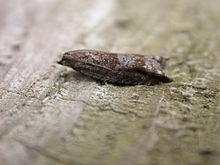Rhopobota naevana
| Rhopobota naevana | |
|---|---|

| |
| Scientific classification | |
| Domain: | Eukaryota |
| Kingdom: | Animalia |
| Phylum: | Arthropoda |
| Class: | Insecta |
| Order: | Lepidoptera |
| Family: | Tortricidae |
| Genus: | Rhopobota |
| Species: | R. naevana
|
| Binomial name | |
| Rhopobota naevana | |
| Synonyms | |
| |
Rhopobota naevana, the holly tortrix moth, holly leaf tier or blackheaded fireworm, is a moth of the family Tortricidae. It is found from Europe (including the British Isles) to eastern Russia, China (Tianjin, Hebei, Inner Mongolia, Liaoning, Jilin, Heilongjiang, Zhejiang, Anhui, Fujian, Jiangxi, Henan, Hubei, Hunan, Guangdong, Sichuan, Guizhou, Yunnan, Tibet, Shaanxi, Gansu), Taiwan, Mongolia, Korea and Japan.[2] It is also present in India, Sri Lanka and North America.
The wingspan is 12–16 mm. Adults are on wing from late June to early September.
The larvae feed on Vaccinium, Erica carnea, Ilex, Malus, Crataegus, Sorbus, Prunus, Pyrus and Rhamnus. The larvae can be a pest on cultivated apple, pear and cranberry, eating young leaves, flowers and occasionally, newly set fruits. They can also kill young lateral shoots.
